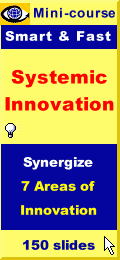|
New Realities and New Survival
Strategies
In today's tidal wave of global economic,
technological, and social change, the name of the game for you and your
organization is survival. You are not going to survive in this
new economy
through
technology innovation
alone.
The New
Era of Systemic Innovation
Innovation
used to be a linear trajectory from new knowledge to new product.
Now
innovation is neither singular nor linear, but
systemic. It arises from complex interactions between many
individuals, organizations and their operating environment. Firms which
are successful in realizing the full returns from their technologies and
innovations are able to match their
technological developments with complementary expertise in other
areas of their business, such as manufacturing, distribution, human
resources,
marketing, and
customer service.
 Innovation is not divisible –
‘good in parts’ is no good at all.
Innovation systems are only as strong as their weakest links. "You
can't do carpentry if you only have a saw, or only a hammer, or you
never heard of a pair of pliers. It's when you put all those tools into
one kit that you invent," advised Peter Drucker. Innovation is not divisible –
‘good in parts’ is no good at all.
Innovation systems are only as strong as their weakest links. "You
can't do carpentry if you only have a saw, or only a hammer, or you
never heard of a pair of pliers. It's when you put all those tools into
one kit that you invent," advised Peter Drucker.
Holistic Approach
Innovation is the key driver of
competitive advantage, growth, and profitability. There are many
parts of the whole field of innovation:
strategy innovation,
new product development,
creative approaches to problem solving,
idea management, suggestion systems, etc. All of these components
are important. "Yet approaching them piecemeal will bring piecemeal
results...
These seemingly disparate issues must be integrated into a
single overarching strategy if they are to be mobilized in the quest for
growth," says Robert Tucker. In this new era of systemic innovation,
you must design your firm's
innovation process holistically.
Systems Thinking
Systems thinking is your ability to things as a whole (or holistically)
including the many different types of relationships between the many
elements in a complex system. "Systems
thinking is a sensibility – for the subtle interconnectedness that gives
living systems their unique character," says Peter Senge.
Radical Innovation by
Cross-Functional Individuals
"Here is the
paradox: You need a great team of people with diverse skills to perform a
symphony well, but no team has ever written a great symphony!" –
Ken Matejka
While
cross-functional teams are key players in defining and implementing
incremental innovation projects,
cross-functional disruptive individuals tend to be key players in
defining
radical innovation projects. Individuals who are likely to excel in a
radical innovation project, besides having superior technical capabilities,
should be goal-oriented, broadly educated, creative, extremely bright, not
afraid to be different, integrative, flexible, passionate, entrepreneurial,
aggressive, eager to learn business, able to take risks, and inquisitive.
Manage Systemic Innovation by
Cross-Functional Teams
In
strategic innovation road-mapping, the starting point for knowledge
building and learning about the innovation concept is to establish a shared
view of trends, disruptive technologies and other discontinuities, and
related events that could shape the future. To move efforts forward,
cross-functional teams, either formal or informal, need to be formed.
For incremental innovation product or service development projects, a
cross-functional team typically includes a technical guru, engineer,
designer, manufacturing expert, supply chain specialist, and marketing
specialist. Your major suppliers and customers need also to be kept well
informed of your new product/service development plans and allowed to work
together to build these new solutions.
Cross-functional Management (CFM)
Cross-functional management (CFM)
manages business processes across the traditional boundaries of the
functional areas. CFM relates to coordinating and
synergizing the activities of
different units for realizing the superordinate cross-functional goals and
policy deployment. It is concerned with
building a better system for achieving such cross-functional goals as
innovation,
quality,
cost, and delivery...
More
|